Cluj-Napoca: A Travel Guide to Transylvania’s Vibrant Capital
This travel guide covers the sights of the vibrant university city of Cluj (Cluj-Napoca) in Romania’s Transylvania region.
A visit to Cluj
After a comfortable domestic flight with TAROM, I arrived in Cluj-Napoca, Romania’s second-largest city and the unofficial capital of the region of Transylvania.
Cluj-Napoca – or simply Cluj, as nearly everyone calls it – has always been close to my heart, as I previously lived here for a year and still have many friends in the city.
Since I moved out of Cluj about a decade ago, the city has undergone a remarkable transformation from a lively university town in an overlooked corner of Europe to a thriving hub of business and commerce.
In recent years, many large foreign companies and Romanian start-ups, primarily in IT and finance, have set up in Cluj, creating new jobs and leading to a significant population increase.
The rise in low-cost flights from Cluj-Napoca Airport to destinations across Europe, along with the growing international popularity of the city’s major music festivals — Untold, held in the city, and Electric Castle, held at Banffy Castle in nearby Bonțida — has made Cluj increasingly popular among tourists.
I fondly remember living in a nice, spacious flat in the heart of Cluj for €250 a month — a price that would now be at least double, if not triple this amount in rent, as the housing prices in the city have become even more expensive than the Romanian capital of Bucharest.
Fortunately, Cluj still retains much of its original, laidback charm to entice visitors, and you’ll soon discover that there is plenty to see and do in and around the city.


Piața Unirii and St. Michael’s Church
Cluj-Napoca Airport is located just a few kilometres east of the city centre, and after a short bus ride, I soon found myself at Piața Unirii, the central square of Cluj-Napoca.
Piața Unirii, meaning Union Square in Romanian, refers to the unification of Romania on 1 December 1918, when Transylvania, along with Maramureș, Crișana, and the Banat, joined the Kingdom of Romania — a union formalised after the First World War by the Treaty of Trianon.
In the years before World War I, Transylvania was part of the Austro-Hungarian Empire, and Cluj was known around Europe by its Hungarian name, Kolozsvár.
Transylvania has always been a multi-ethnic region, and although Romanians formed a majority in the region as a whole, there were some areas and cities where Hungarians actually constituted the majority.
This was also true in Cluj, where Hungarians formed either a majority or plurality until well after the Second World War, when ethnic Romanians became the majority.
Today, ethnic Hungarians make up 13.9% of the population — a sizeable minority, though far from their dominant presence throughout much of Cluj’s history.
However, it does mean that many of the historic buildings in the heart of Cluj are primarily connected to Hungarian history and culture.
The large Gothic-style church on Piața Unirii, St. Michael’s Church, is a Hungarian Roman Catholic church.
St. Michael’s Church was completed in 1487, though its current 76-metre-high clock tower (80 metres including the cross) was only added in 1862, replacing an older Baroque bell tower.
The clock tower of St. Michael’s Church is the tallest of all church towers in Transylvania, and although its viewing platform is not always accessible, the views from the top are well worth the climb during the irregular times it is open to visitors.
The nave of St. Michael’s Church is certainly impressive in size as well, and it’s no surprise that it’s the second largest church in Transylvania after the Black Church in Brașov.
When you’ve visited the church and find yourself back on the main square, try to spot the cannonball embedded in the southern exterior wall of St. Michael’s Church, a remnant of an Ottoman bombardment in 1603!

Other sights on and around Piața Unirii
There is much more to see and do around Piața Unirii beyond admiring St. Michael’s Church.
In front of the church stands an equestrian statue of Matthias Corvinus, who was born in Cluj in 1443 and became King of Hungary in 1458.
Matthias Corvinus brought significant political, economic, and military reforms, along with Renaissance art and culture, to his lands in Central Europe during his reign from 1458 to 1490, and he is still regarded as one of the most influential Hungarian kings in history.
Piața Unirii is also home to many appealing cafés and restaurants, many of them housed in ornate buildings.
The square has been neatly remodelled by the Cluj city authorities in recent years, transforming what was a traffic-clogged street just a decade ago into a lively cobblestoned area with outdoor terraces where you can enjoy a drink or meal.
Indeed, as I hadn’t really managed to eat breakfast after my early morning flight from Bucharest to Cluj, I sat down at one of the outdoor terraces to enjoy a croque madame, coffee, and some orange juice.





Museums
On the eastern side of Piața Unirii, you will find a couple of other sights along with some of the best museums in Cluj-Napoca.
The Pharmacy Museum, located opposite the Lutheran Church at the busy intersection in the north-eastern corner of the square, features a 16th-century pharmacy and should appeal to anyone interested in medicine.
Another notable building on the eastern side of Piața Unirii is the 18th-century Bánffy Palace with its wonderful Baroque façade, which now houses the Cluj-Napoca Art Museum.
Other museums worth visiting in Cluj include the Ethnographical Museum of Transylvania and the National History Museum.
When you stand on the eastern side of Piața Unirii, don’t forget to take your time to admire the symmetrical buildings with their eclectic façades on both sides of Strada Iuliu Maniu, known locally as strada oglindă (Mirror Street).



Old town of Cluj
When you walk south from Piața Unirii on Strada Universității (University Street), you pass some other Cluj landmarks, such as the Cinema ARTA, an art house film theatre built in eclectic style but featuring a fine Art Deco interior, along with the Roman Catholic Holy Trinity Church.
In this area, you will find a couple of the main faculties (History, Philosophy, Law, among others) of Babeș-Bolyai University, the largest and most renowned of all the universities in Cluj.
It is the local student population — about a quarter of the entire resident population — that makes Cluj-Napoca such a lively city.
The cafés and restaurants in the old town of Cluj are therefore buzzing with activity, as students go out for coffee or lunch between classes or enjoy some beers afterwards.
One of the most charming parts of Cluj is the quarter to the south-west of Piața Unirii, where you will discover some of the oldest streets and buildings in town.
On Strada Potaissa, you can still see the old city walls of Cluj.
It is one of only two places in the city where you can find remnants of the old fortifications, the other being the Turnul Croitorilor (Tailors’ Tower) just behind the theatre to the south-east of the old town.
Although Cluj-Napoca can trace its origins back to a Roman castrum (fort) named Napoca, the modern city was actually founded by German settlers in the 13th century.
These German settlers, known as the Transylvanian Saxons, were invited into the region by the Hungarian rulers of Transylvania, who could use their education and skills as gifted craftsmen to improve the economy and bolster defences against foreign invaders.
In Transylvania, they founded seven fortified cities known as the Siebenbürgen, which means “seven castles” in German.
Cluj, or Klausenburg as the Transylvanian Saxons call the city, was one of these seven fortified cities, although nowadays there are hardly any Germans left in town, unlike the Hungarians who still form an integral part of society.
Interesting fact: The suffix -Napoca was only added to the name of Cluj in 1974 under the reign of dictator Nicolae Ceaușescu to emphasise the city’s Latin roots and to annoy the local Hungarian community during the often forced process of Romanianisation by the Romanian communist authorities.
After you have admired the city walls, it is also well worth exploring the other cobblestoned streets in this part of the old town of Cluj, such as Strada Inocențiu Micu Klein.
A nice place to stop on this street for beers or delicious goulash is the Hungarian-run Café Bulgakov.
Although you won’t easily find an ethnic Romanian who speaks Hungarian (partly because the language is incredibly hard to learn), most ethnic Hungarians in larger cities such as Cluj are perfectly bilingual and can speak both languages fluently.




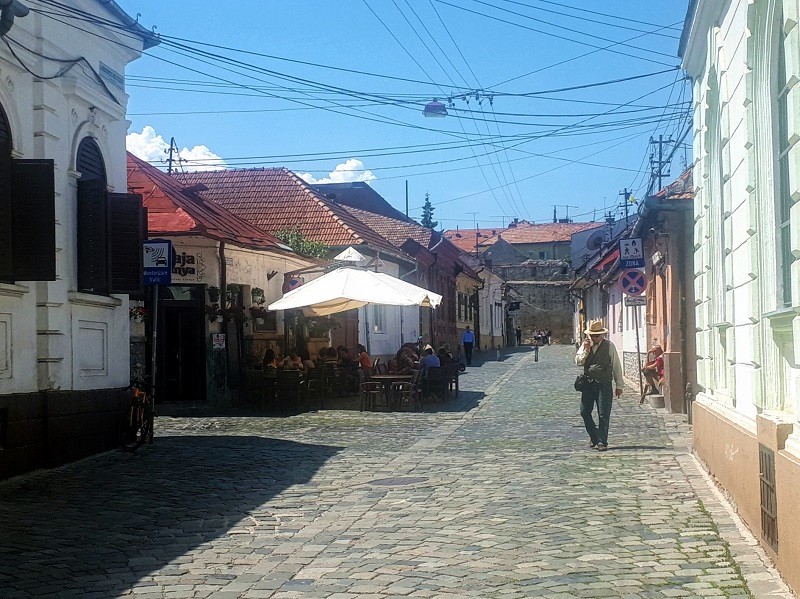
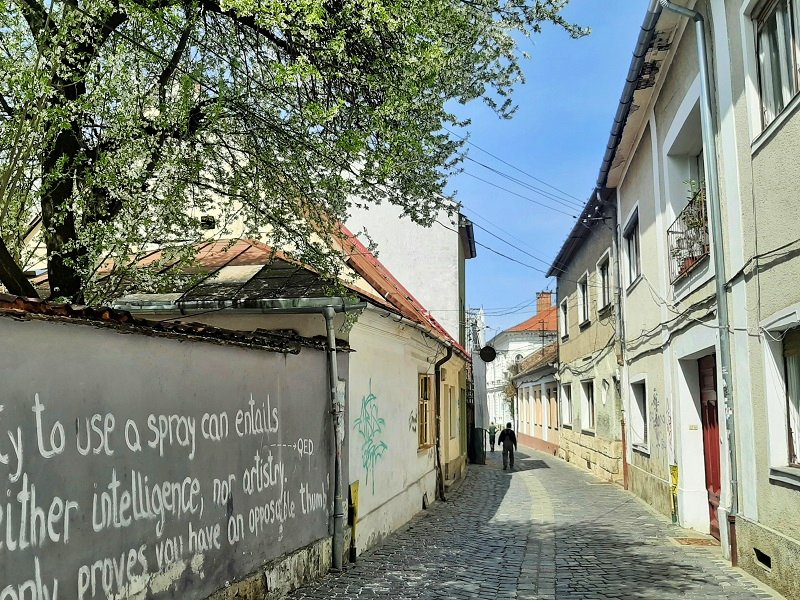



Central Cemetery
Another sight in the southern part of the old town of Cluj is the Central Cemetery.
Built on the slope of a hill, the Central Cemetery features beautiful old mausoleums and tombstones, and especially during autumn, this Transylvanian graveyard has a slightly eerie and spooky charm.
The pictures below were taken during another trip I made to Cluj in autumn.



Museum Square and beyond
Another beautiful part of Cluj-Napoca’s old town lies directly to the north of Piața Unirii, where you will find many more charming cobblestoned streets and squares.
When you walk up the pedestrianised street across from St. Michael’s Church to the north, you will first come across an impressive medieval house with whitewashed walls, a red-tiled roof, and a large wooden gate, which was actually the birthplace of Matthias Corvinus.
A bit further north lies the lovely Piața Muzeului (Museum Square), another fine part of the old town full of outdoor cafés, with the 12th-century Franciscan Church providing a beautiful backdrop.
Much of the charm of Cluj lies in these quaint streets and squares, and their cafés, pubs, and restaurants create a great atmosphere for absorbing the laid-back, easy-going local life.


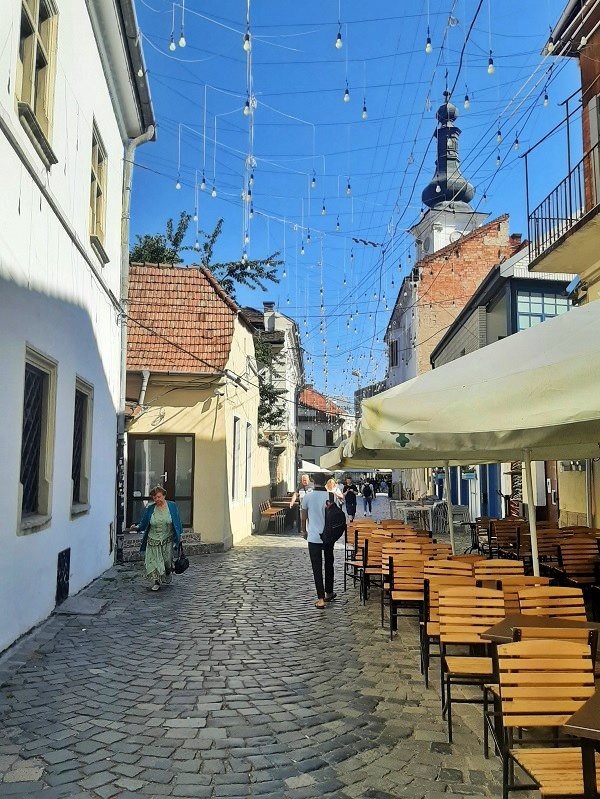


Central Park
When you find yourself in Museum Square, it’s only a short walk out of the old town to reach the eastern side of Parcul Central (Central Park), a beautiful green space in the heart of Cluj.
At the eastern side of Central Park, you can find the Hungarian State Opera and the Anti-Communist Resistance Monument.
As you walk through the park towards the west along perfectly landscaped paths flanked by tall trees, you will reach the Old Casino, Pavilion, and a large pond where local families enjoy rowing boats or swan pedal boats on sunny days.
At the far end of the large pond, you will find the café-restaurant Chios, a beloved historic venue where you can enjoy a drink or a meal.
Another good place to sit down with a beer or grab a bite to eat around Central Park is Euphoria Biergarten, located on a villa-lined street at the southern edge of the park.
This time, I decided to skip the beer and just ordered a refreshing homemade lemonade and a delicious tarte Tatin with some ice cream.


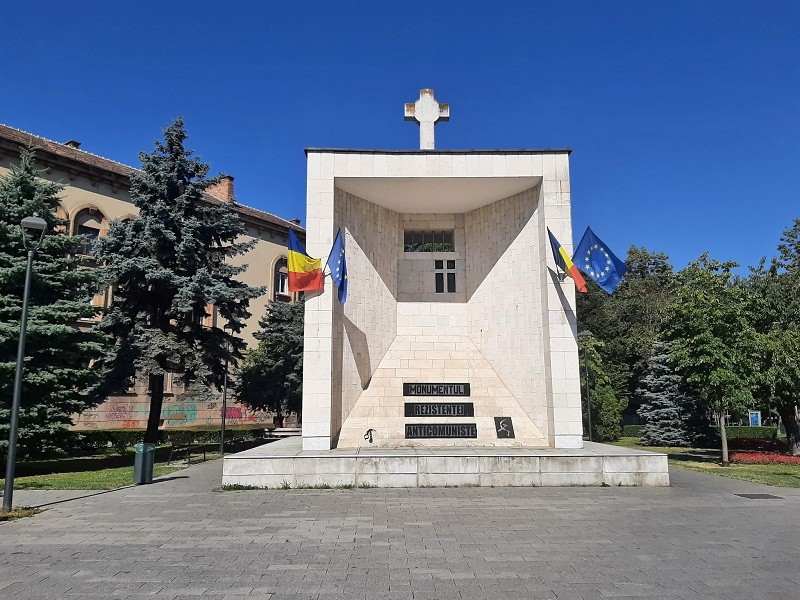





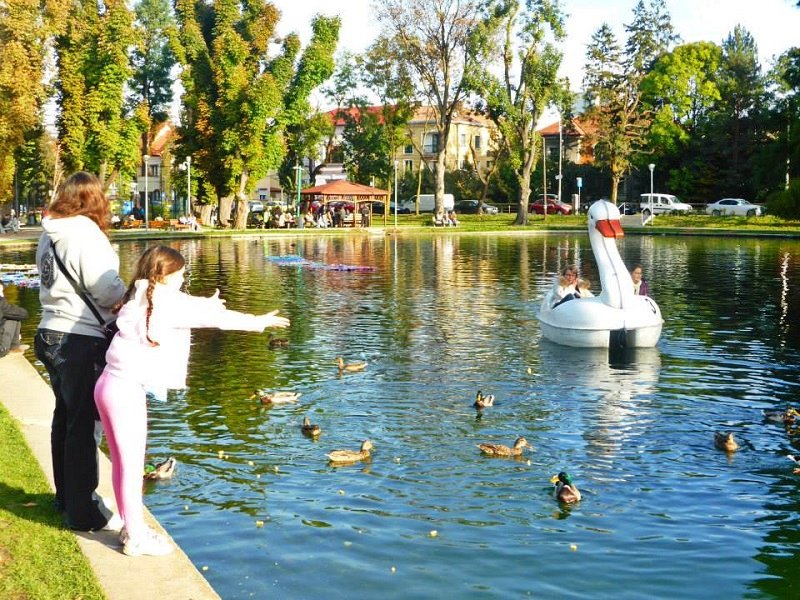



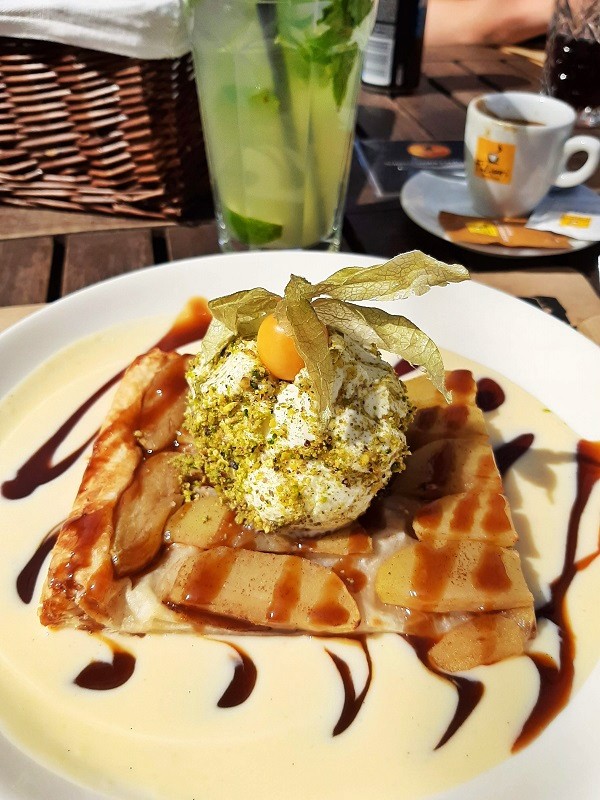
Ursus
From Central Park, I headed south until I reached Calea Moților, the main road leading out of the city to the west.
On Calea Moților, it was a short walk to reach Fabrica de Bere, a brewpub and restaurant owned by Ursus, one of Romania’s leading beer brands.
Ursus used to be the iconic beer brand of Cluj, but since being taken over by a large multinational, production was sadly moved to Buzău, and the old brewery in Cluj’s city centre was closed down, demolished, and replaced by a modern residential and commercial complex.
Even though Ursus is no longer brewed in Cluj, the company now produces Bârlog craft beer at the Fabrica de Bere brewpub, and while the beers are nothing special (and can’t really be called craft beer in the first place since it’s owned by a large multinational), the venue still makes for a pleasant spot to enjoy a few pints.
For those who are into craft beer, do try the delicious beers from the local craft brewery Hophead Brewing at one of the few bars or restaurants in Cluj that serve them.



Hașdeu Campus
From Fabrica de Bere, it was only a short walk to reach the Hașdeu Campus, which is perhaps the heart of student life in Cluj-Napoca, with its dozens of dormitories, as well as the nearby Faculty of Geography at Babeș-Bolyai University and the sprawling complex of the Iuliu Hațieganu University of Medicine and Pharmacy.
This area is a great place to experience student life in Cluj, with the bars and cafés on Strada Piezișă often bustling with students during the academic year.
Right in between some of the Hașdeu dormitories, you can find the lovely Biserica Studenților (Students’ Church), designed in the same style as the famous wooden churches of the Romanian region of Maramureș.
From Hașdeu, I walked back towards the city centre along Calea Moților, passing the yellow-and-white façade of Cluj-Napoca City Hall and its large clock tower.


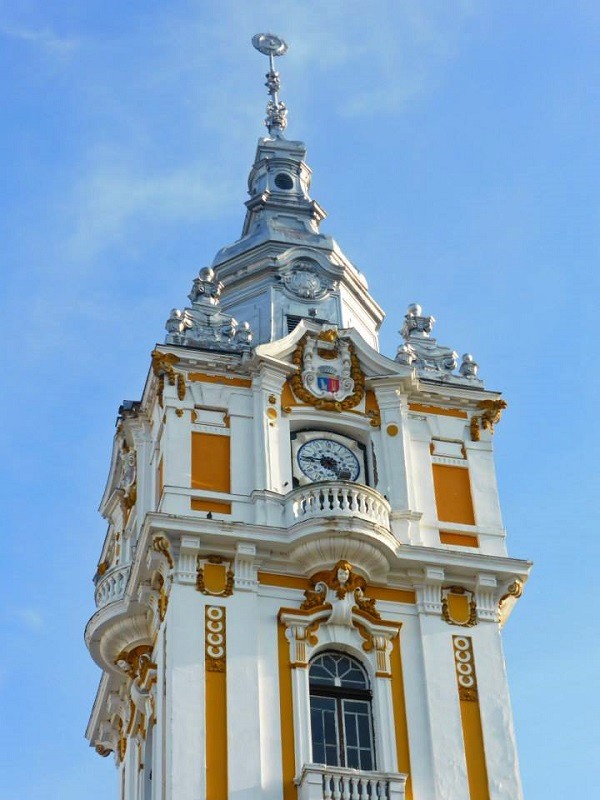
Eroilor Boulevard
Having explored the sights to the west of the central square, Piața Unirii, it was now time to head east and visit some major landmarks in that part of Cluj.
Bulevardul Eroilor (Heroes Boulevard), with its wide pavement and beautiful façades, makes for a pleasant stroll to the east of the city centre.
There are two notable monuments on Bulevardul Eroilor.
One monument commemorates the signatories of the Transylvania Memorandum, a petition presented in 1892 by Romanian community leaders in Transylvania to Austro-Hungarian Emperor Franz Joseph, demanding equal rights to those of the Hungarian population.
The petition was promptly ignored and resulted in the Romanian leaders being prosecuted and sentenced for incitement, although they were released after a few months following a royal amnesty decree.
You can also find a small statue of Romulus and Remus on Bulevardul Eroilor, a common symbol seen in any sizeable Romanian town that highlights the Latin roots of the Romanian people and language.




Piața Avram Iancu
Two of the biggest sights in Cluj are located on Piața Avram Iancu, a square named after the Romanian national hero and revolutionary Avram Iancu.
Across the road at the southern end of the square lies the magnificent National Opera of Cluj-Napoca.
Although the National Opera of Cluj-Napoca looks beautiful from the outside, it’s the interior that is truly spectacular, so be sure to check the performance schedule to see if there is an opera or concert you can attend when you travel to Cluj.
In the middle of the square, you can find some fountains surrounding a statue of Avram Iancu atop a large pedestal.
There are often market stalls on Piața Avram Iancu where you can buy local delicacies, handicrafts, or travel souvenirs to take home from your trip to Cluj.
At the northern end of the square, you can find the Romanian Orthodox Metropolitan Cathedral of the Dormition of the Mother of God, which is certainly impressive in size.



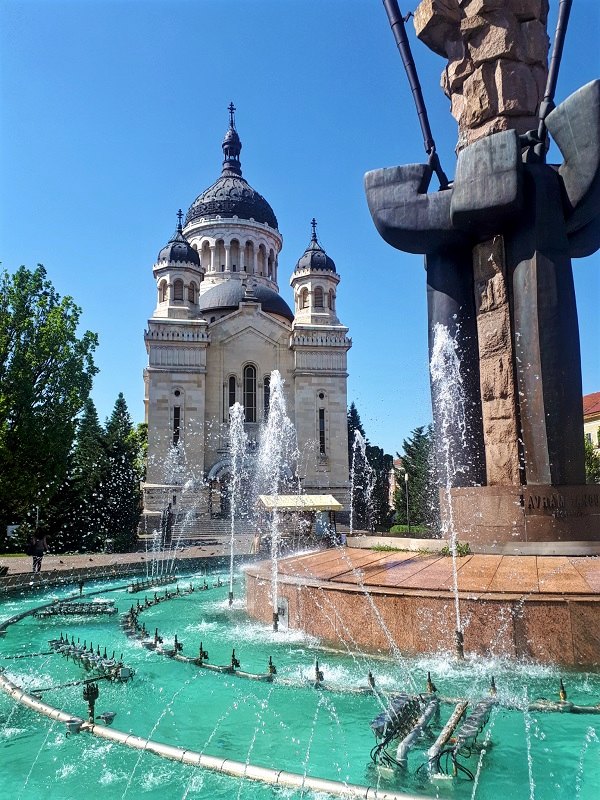

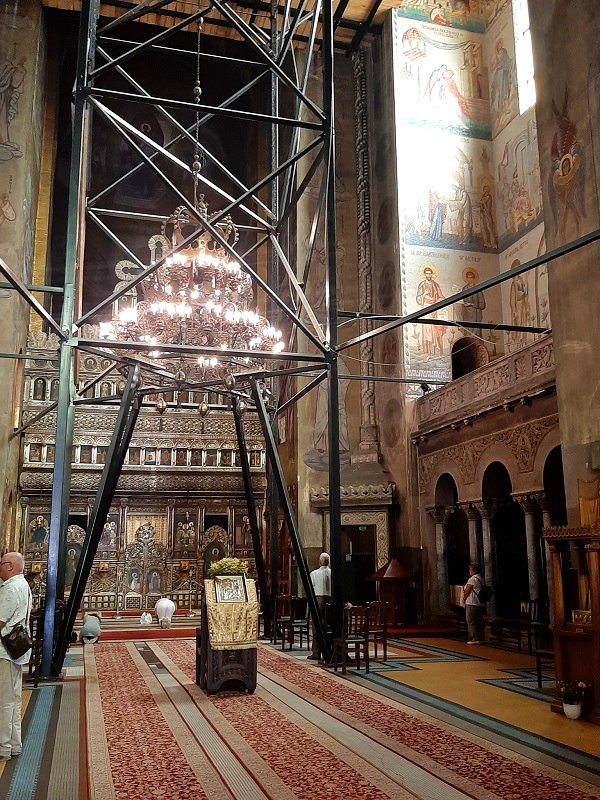

Around Piața Avram Iancu
If you look south from Piața Avram Iancu, you will spot another church in the near distance, an even larger Greek-Catholic Cathedral that has been under construction for ages, with no end to the work in sight.
These megalomaniac churches are all the rage in Romania, with cities like Bucharest also having their own mega church in a state of endless construction.
A century ago, people certainly had a better taste in architecture and design.
This is demonstrated by the grand buildings surrounding Piața Avram Iancu that were constructed around the turn of the century, including the Palace of Justice with its eclectic style and the Palace of the Cluj County Prefecture featuring its stunning Art Nouveau design.
However, it’s not worth venturing further east, as you will soon reach the Mărăști neighbourhood, characterised by massive and rather ugly communist-era blocks of flats from the 1970s and 80s that may perhaps appeal to some, but holds little interest for the average traveller.





Cetățuia Park
Cluj is essentially built in the valley of the Someşul Mic river that runs from west to east, making the city much longer than it is wide, as it is bordered by hills to the north and south.
On the hills across the river to the north of Cluj’s city centre, you can find Parcul Cetățuia (Citadel Park), which is another sight worth visiting.
Between 1715 and 1735, a massive citadel complete with a redoubt, a tower, and several bastions was constructed on this hill under the auspices of the Habsburg rulers.
Most of these fortifications were dismantled after they fell into disrepair and no longer served their purpose, and nowadays the citadel hill is home to a pleasant park, a communist-era hotel (the Belvedere), and a huge iron cross.
From the hilltop park, you can enjoy sweeping views over the city of Cluj, so it’s worth making the effort to climb the steps up.




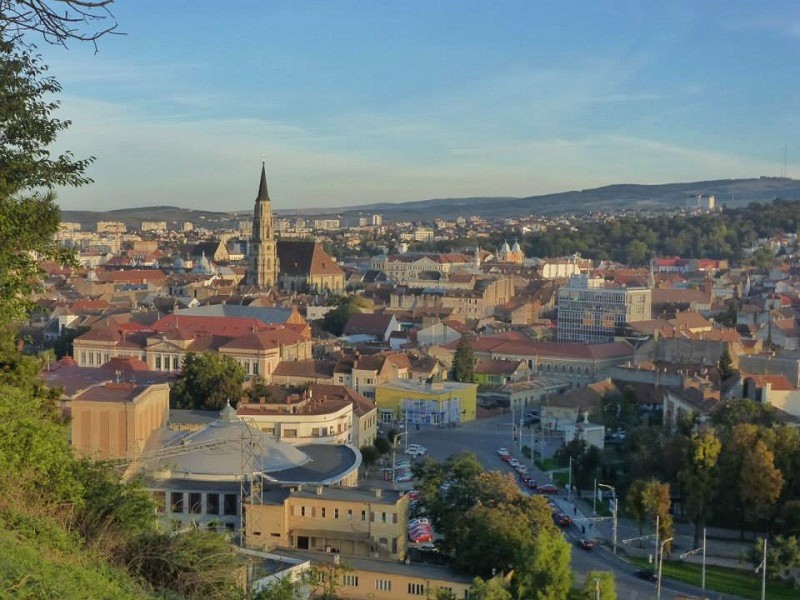
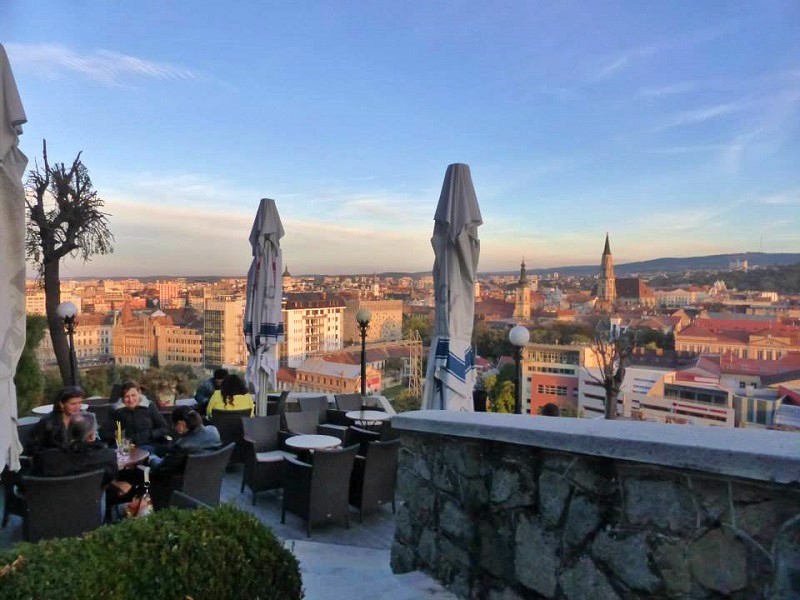



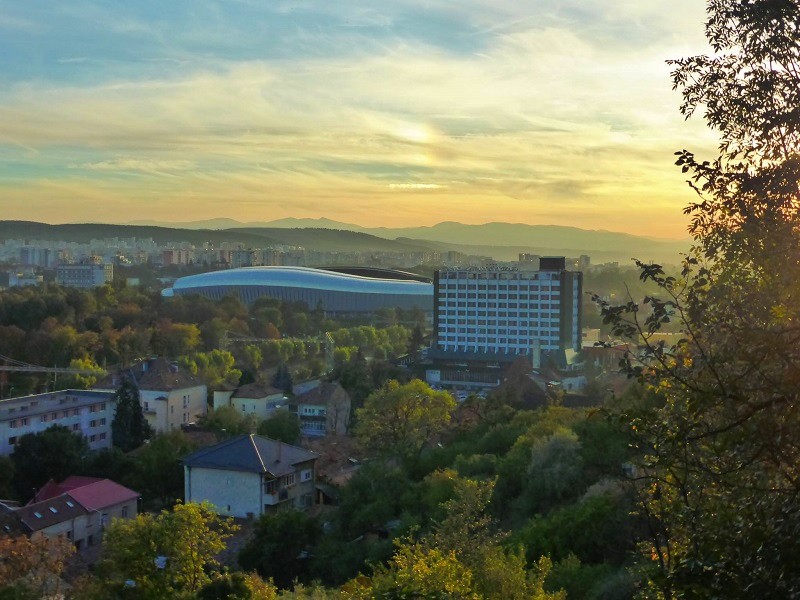
Cafés and bars in Cluj
For such a youthful city, it’s unsurprising that Cluj-Napoca has a wide range of quality cafés, bars, and pubs.
Many of these bars have their own themes, clientele, or distinct styles, so it’s worth reading up, asking around, or simply exploring the city to find one that matches your preferences.
One of my old favourites in Cluj is Samsara Teahouse, which should not be confused with Samsara Foodhouse, a restaurant that serves excellent vegan and vegetarian dishes.
Samsara Teahouse is situated in an old villa just down the hill from Citadel Park and features three uniquely decorated rooms, along with a large garden at the back that has cosy seating areas as well as hammocks.
Unsurprisingly, Samsara offers an extensive tea menu, but if you prefer a drink, you can also find beer and wine, along with nargilah for those who enjoy smoking.
Samsara is a pleasant place to laze away for a while, although the place is so laid-back it even has an effect on the serving staff, as service can be really slow!
During my visit to Cluj, I enjoyed some white wine and nargilah in the garden while reading an excellent book about Central Asia (Peter Hopkirk’s ‘On Secret Service East of Constantinople’) to get into the mood for my upcoming travels to the region.
Other personal favourites of mine for a drink in Cluj include Insomnia, Zorki, Hemingway, Klausen Pub, Shto, and Atelier Café, while bars like Enigma and Joben are well-known for their Steampunk décor.


Klausenburger
As I began to feel thirsty again soon after I left Samsara, I walked towards the Centrul Comercial Central, an unattractive shopping centre just north of Unirii Square, which has one interesting feature: A lovely rooftop pub and restaurant called Klausenburger.
I spent some time sampling their craft beers while admiring the fine views of Cluj from the rooftop terrace.






Restaurants
After enjoying a couple of beers on the rooftop, I headed back down and walked through the old town in search of a place for dinner.
Cluj boasts many high-quality restaurants, making it easy to find an appealing spot that serves good food, regardless of your taste or budget.
For Romanian cuisine in Cluj, Vărzărie is a great restaurant, with the local favourite being Varză à la Cluj (Cluj-style cabbage), though you can’t go wrong with more typical Romanian dishes like mici (grilled minced meat sausages) or one of the traditional ciorbăs (soups).
Da Pino serves excellent Italian cuisine, NATIV is a top-quality steakhouse, Marty is a popular local chain restaurant with a diverse menu, and Casa Boema is also a reliable option.
This time, I opted for Hungarian cuisine at Rhédey Café, where I enjoyed a hearty beef stew with dumplings.
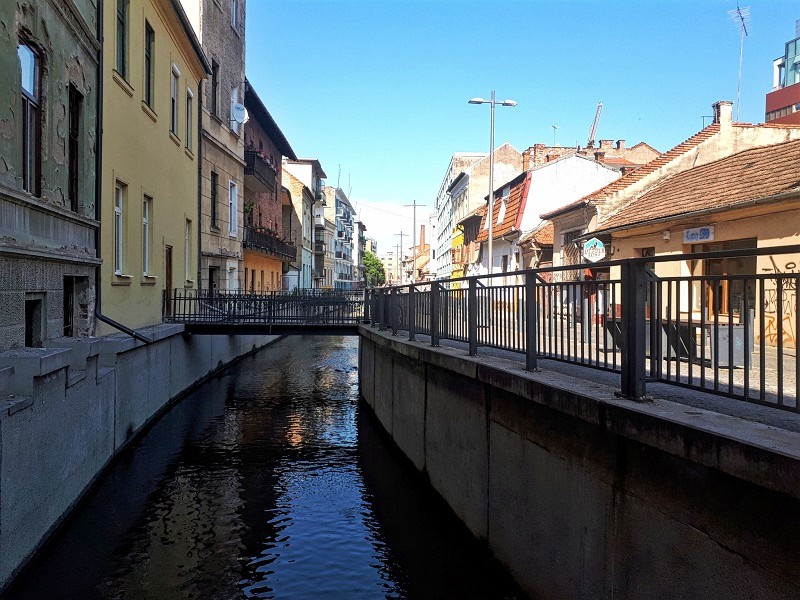


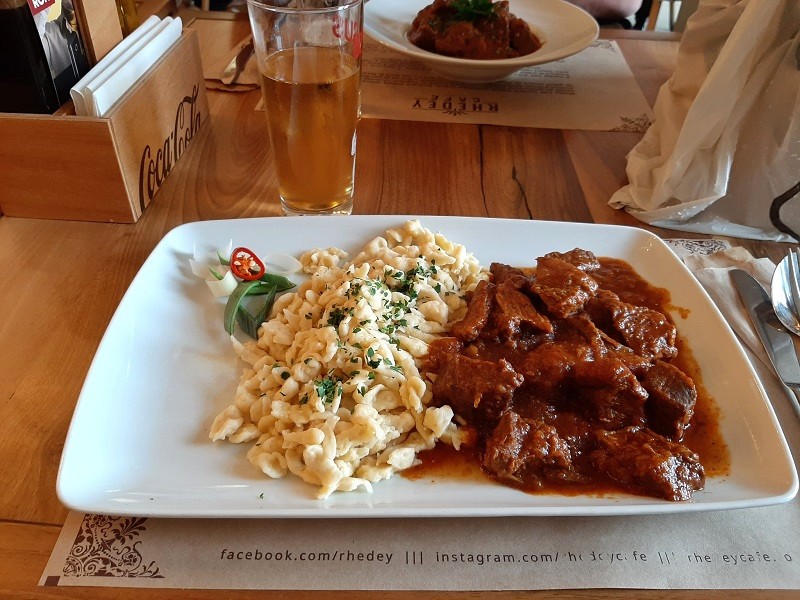
Botanical gardens
A beautiful sight in Cluj that I sadly didn’t have time to visit on this trip is the Alexandru Borza Cluj-Napoca University Botanic Garden.
These beautiful botanical gardens are absolutely sprawling, with some areas feeling more like a forest far away from the city than a park.
Among the highlights of the botanical gardens in Cluj are the stunning Japanese garden and the tropical plants in the greenhouse.
Below are some pictures I took of the botanical gardens during a previous trip to Cluj-Napoca in autumn.




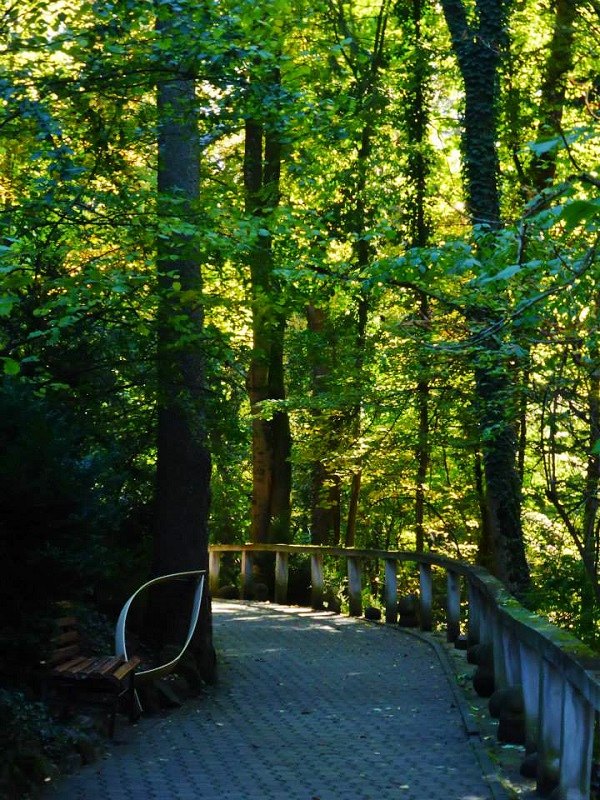



Cluj-Napoca day trip
When you visit Cluj-Napoca, it’s well worth taking a day trip outside the city, with Turda being the most obvious destination.
Turda is located just 30 kilometres south of Cluj, and if you travel by car or minibus, it takes only about 30 minutes to reach it.
Although Turda is a pleasant enough town, its main sights are located outside the centre.
Salina Turda (Turda Salt Mine) is a highly spectacular sight featuring a pond with boat rides and a small amusement park, both located deep underground.
The Cheile Turzii (Turda Gorge) is an impressive canyon through which you can hike, making it an ideal spot to enjoy the beautiful Romanian nature when you travel to Cluj.
I will detail the specifics of a day trip from Cluj-Napoca to Turda in the next chapter of this trip report.


Cluj memories
Something I always do when I revisit Cluj is walk from Piața Unirii down Strada Regele Ferdinand and its extension across the river, Strada Horea, and this was exactly what I did this time as well after my dinner.
This is where I lived during my year in Cluj, and walking by my old apartment always brings back some fond and bittersweet memories.
Even though Cluj-Napoca is not as picturesque as the other main travel destinations in Transylvania like Brașov, Sibiu, and Sighișoara, which all have more uniform and better preserved old town centres, I still think Cluj is the most fun-loving and vibrant of the four.
As I was walking down Horea Street and reflecting on my day in Cluj, I was again reminded of this.
At the far end of Strada Horea lies the railway station of Cluj-Napoca, the place where I have so often arrived or departed on my Romanian train travels.
This time around, it would not be a train by which I would leave Cluj, as the next day I would head back to the Cluj-Napoca Airport for my Turkish Airlines flight to Istanbul and Minsk.
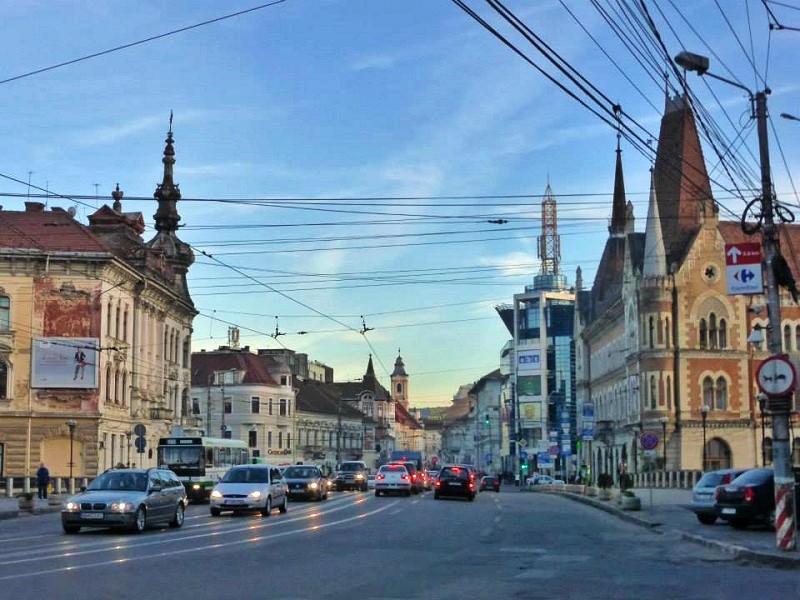




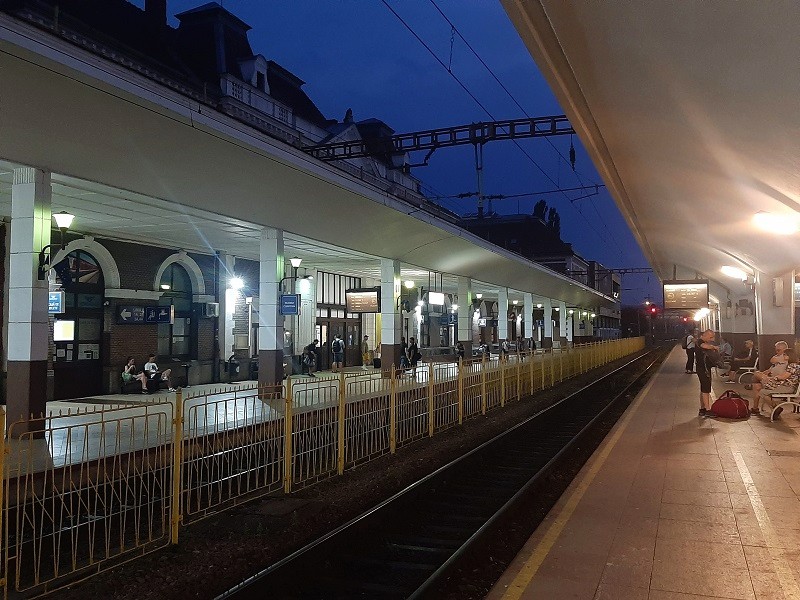
Conclusion
Cluj-Napoca, or simply Cluj as the locals call it, is a vibrant university city with a lively café culture and interesting historic sights.
As the unofficial capital of Romania’s Transylvania region, Cluj has a lot of Hungarian and Germanic influences that are easily noticeable when you walk through the cobblestoned streets of the old town.
When you visit Cluj, make sure to admire its fine churches, such as the Roman Catholic Saint Michael’s Church and the Romanian Orthodox Cathedral, as well as the city’s eclectic architecture showcased in buildings like the National Opera and various administrative buildings.
Most of all, travelling to Cluj is all about sampling the city’s diverse and high-quality array of cafés, bars, and restaurants of the city.
As a major university city, Cluj is teeming with life, and to explore it to the fullest, you are well advised to go with the laid-back local flow.
Trip report index
This article is part of the ‘Back to Central Asia: Travels Through Kazakhstan and Kyrgyzstan‘ trip report, which consists of the following chapters:
1. Review: TAROM Domestic Flight Bucharest to Cluj-Napoca
2. Cluj-Napoca: A Travel Guide to Transylvania’s Vibrant Capital (current chapter)
3. Turda Salt Mine and Gorge: An Easy Cluj-Napoca Day Trip
4. Review: Turkish Airlines Economy Class Cluj-Istanbul-Minsk
5. Minsk, Belarus: Chasing Soviet Ghosts in One of Europe’s Last Dictatorships
6. Review: Turkish Airlines Business Class Minsk-Istanbul-Almaty
7. A Visit to Almaty, Kazakhstan’s Vibrant Economic Capital
** rest of the chapters to follow soon **

